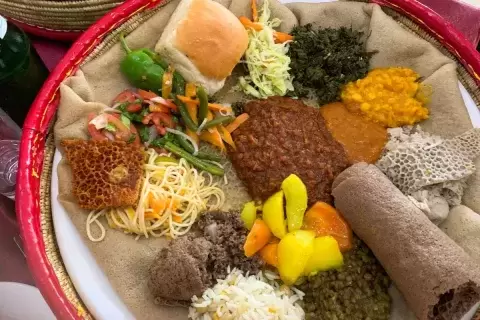Injera, a traditional Ethiopian and Eritrean staple, is a mouthwatering fermented flatbread that serves as the foundation for many meals. Made from teff flour, it has a spongy texture and a slightly tangy taste. Injera is often used as both a plate and an accompaniment to various stews and curries.
Diners tear off pieces of Injera to scoop up the flavorful dishes, creating a communal and interactive dining experience. Its unique taste and texture make it a must-try for anyone exploring East African cuisine.
Introduction
Welcome to my food blog, where we explore the vibrant world of global cuisine. Today, we embark on a culinary journey to Ethiopia to discover the secrets of preparing the beloved Injera.
This spongy, sourdough flatbread is a staple in Ethiopian cuisine and is enjoyed with a variety of flavorful stews and dishes.
Join me as we dive into the recipe, preparation techniques, cultural significance, and serving suggestions of this delectable traditional delight!
Recipe
Ingredients
- 2 cups teff flour (or a mixture of teff and all-purpose flour)
- 1 cup water (plus more for fermentation)
- 1/2 teaspoon active dry yeast
- 1/2 teaspoon salt (adjust to taste)
Preparation
- In a large mixing bowl, combine the teff flour and water to create a smooth batter. If you can't find teff flour, you can use a mixture of teff and all-purpose flour. Teff flour will yield a more authentic injera taste and texture.
- Dissolve the yeast in a small amount of warm water and add it to the batter. Mix thoroughly, ensuring there are no lumps. Cover the bowl with a clean kitchen towel and let it ferment for at least 24 to 48 hours. The longer fermentation period results in a tangier flavor, so adjust according to your preference.
- After fermentation, you'll notice small bubbles on the surface of the batter, indicating that the fermentation process is complete. Stir the batter gently and add salt to taste.
- Preheat a non-stick skillet or a specialized injera pan (mitad) over medium heat. If using a regular skillet, lightly grease it with oil.
- Pour a ladleful of the batter onto the skillet, starting from the center and moving outward in a circular motion. The batter should spread thinly to create a large, round injera. If the batter is too thick, you can add a little water to achieve the desired consistency.
- Cover the skillet and cook the injera for 1-2 minutes until the edges start to curl up and the surface appears dry. Injera is traditionally only cooked on one side, so there's no need to flip it.
- Remove the injera from the skillet and place it on a clean kitchen towel to cool. Repeat the process until all the batter is used, stacking the injera on top of each other.
Serving Suggestions
Injera is often used as both a utensil and a base for Ethiopian dishes. Here are some serving suggestions:
- Classic Ethiopian Combo: Serve injera alongside a platter of various Ethiopian dishes, such as Doro Wat (spicy chicken stew), Alicha Sega Wat (mild beef stew), or Misir Wat (spiced lentil stew). Tear off a piece of injera, scoop up the stews, and savor the harmonious flavors.
- Vegetarian Delight: Pair injera with a variety of vegetarian dishes like Shiro (spiced chickpea or lentil stew), Atakilt Wat (spiced cabbage, carrots, and potatoes), or Gomen (collard greens cooked with spices). The tangy injera complements the earthy flavors of these dishes beautifully.
- Injera Rolls: Use injera as a wrap and fill it with your choice of grilled meats, sautéed vegetables, and a dollop of Ethiopian spiced butter, Niter Kibbeh. Roll it up and enjoy the burst of flavors and textures.
Nutritional Value
Injera is a nutritious flatbread option. Teff, the main ingredient, is rich in fiber, protein, and essential minerals such as iron and calcium. It is also gluten-free, making injera suitable for individuals with gluten sensitivities or dietary restrictions.
Cultural and Traditional Value
Injera holds great cultural significance in Ethiopia. It is more than just a food item—it is an integral part of Ethiopian communal dining. The act of sharing injera and the accompanying dishes creates a sense of togetherness and camaraderie.
Traditionally, injera is prepared using teff flour, which is native to Ethiopia. This ancient grain has been cultivated for thousands of years, making injera deeply intertwined with the country's heritage and culinary traditions.
Conclusion
Congratulations on mastering the art of preparing injera! This versatile Ethiopian flatbread offers a delightful balance of flavors and textures.
Whether you're hosting an Ethiopian-inspired feast or simply looking to explore new culinary horizons, injera is a must-try. Embrace the cultural and traditional significance as you savor each bite of this tangy and spongy delight. Happy cooking and bon appétit!














